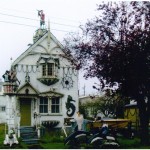June 13, 2013: Update from Carole Witter: “Sadly we could not negotiate saving the house. The owner was in such a rush to take it down and now the empty lot sits barren with no sign of any development. Very disappointing. We did however manage to rescue much of the folk art which is now stored safe and sound in a container at our marina across the street. Our intention is to one day restore the folk art, and who knows, maybe we will build a replica of the old house and embellish it with these unique treasures. Our goal is to keep the folk art in West Bay.”
Esquimalt’s Swallowed Anchor may just get a stay of execution thanks to local resident Carole Witter. Carole says she wants to move the local landmark and its funky folk art across the road to the Hidden Harbour Marina, which she and her husband Jim own.

The Swallowed Anchor, which is nautical lingo meaning to retire from a life of sailing* was built around 1912 and has served as a local tourist attraction for years. Tourists still snap photos, even though the house is in rough shape—and what’s left of the art—a stork with a bundle in its bill, a pirate with telescope and a parrot, King Neptune, a ship’s cannon, and a mermaid are rapidly deteriorating.
John Keziere is the guy behind the art. A carpenter, he owned rental property around Victoria, and when his wife died in the 1970s he decided to move into the Head Street house. Keziere, who was as eccentric as his house, used to dress up as a mermaid costume, row out to a rock in the Inner Harbour and wave at competitors in the annual Swiftsure yacht race.
He died in 1999 and the property sold to Westbay Investments. In November 2010, Mark Lindholm, development manager, told me that the plan was to demolish the house, but save the art and incorporate it into a park—part of a commercial and residential development, anchored with a 10-storey building that would replace Keziere’s house.
Normally that would be the end of the old house, but Carole is a heritage junky, and her hope is that artists and other community members will rally around and help with the restoration. She knows exactly what she’s in for—she’s already been through a massive renovation with her own home, the Steamboat Gothic house a few blocks away.
Carole’s house was built by Captain Victor Jacobsen for his wife Minnie in 1893. The house was built from a pattern book, but Jacobsen, who made his money from seal pelts, added his own touches, decorating their home with floral trim, seabirds, anchors and nautical knots and rope work. The house was saved from the bulldozers in the 1960s by Marguerite and Gilbert Laurenson.

The Witters’ have put a ton of work into their house and received a heritage award in June for their efforts. Carole’s eager to get started on saving the Swallowed Anchor.
“We have removed much of the folk art but there are still a few key pieces on the roof that require a crane or a cherry picker. Our goal is to have these remaining pieces off and in safe keeping by the middle of next month,” she says. “Step two is the process of rescuing the house and moving it across the street to our marina. This requires approval from Council and the building department and a few other hurdles, but no major red flags to date so fingers crossed that we will be successful.”
Mine are crossed. It’s a quirky, eccentric old home that helps give Esquimalt such character.
* Thanks to Victoria Daily Photo for this bit of information
© All rights reserved. Unless otherwise indicated, all blog content copyright Eve Lazarus.


